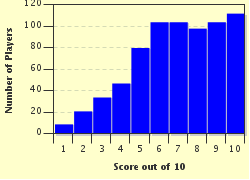Quiz Answer Key and Fun Facts
1. The Battle of Thermopylae was the famed last stand for King Leonidas against what invading power?
2. The Battle of Agincourt lasted for how long before the British were able to defeat the French in 1415?
3. The Battle of Lepanto was a one day battle on October 7, 1571. Where in the world was it fought?
4. The Battle of Nagoshino is named such because it fought along the Nagoshino River.
5. The Battle of Waterloo was most remembered for being the showdown between the Duke of Wellington and Napoleon. But who led the Prussian army alongside Wellington against the French?
6. The Battle of Gettysburg was a defining battle of the American Civil War. What was the official name of the Southern army that General Robert Lee led into battle against the Union?
7. Because of the devastating losses which general, that commanded the Allies in the Battle of the Somme, was criticized for leading what seemed to be a no-win situation?
8. In the Second World War, the Battle of Kursk was a battle fought mostly with what?
9. In what German city did Allied air raids ignite a firestorm on the night of July 27, 1943?
10. As the Vietnam War continued, public support in the United States lessened. Which of these was NOT one of the reasons why this happened?
Source: Author
George95
This quiz was reviewed by FunTrivia editor
bloomsby before going online.
Any errors found in FunTrivia content are routinely corrected through our feedback system.

